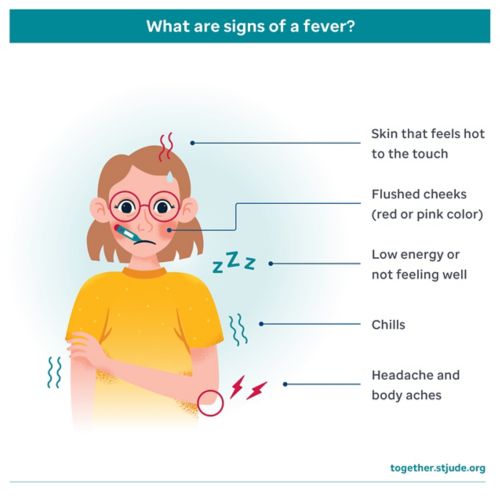Menu
Close
Back
Welcome to
Together is a new resource for anyone affected by pediatric cancer - patients and their parents, family members, and friends.
Learn MoreA fever is an increase in body temperature. The most common cause of fever is an infection caused by germs such as bacteria or viruses. Other causes of fever may include heat exposure, cancer, autoimmune disorders, certain medicines, or immunizations.
Body temperature can vary slightly from person to person and may depend on factors such as time of day and physical activity. The method used to take a temperature can also affect the results.
Read more about how to take a temperature.
In general, a fever is considered to be a temperature of 100.4°F (38.0°C). But the guidelines can vary by:
For children over 3 months of age, fever can be defined as:
In a child younger than 3 months, a fever is an under the arm temperature of 99.4°F (37.4°C) or higher.
Always follow your care team's guidelines for fever.

Fever is a common sign of infection. Sometimes, it is the only sign. Other signs and symptoms of infection may include:
An infection can be life threatening in children with cancer or another illness that causes neutropenia. Neutropenia is a condition that happens when the number of infection-fighting white blood cells (neutrophils) is low.
Patients with neutropenia cannot fight infections well. They can become very ill quickly. If your child has neutropenia, it is important to watch for fever or other signs of an infection. Fever or infection in a patient with neutropenia is a medical emergency.
Contact your health care provider or go to the Emergency Room right away if you notice fever or other signs of infection in your child.
If you go to a doctor or hospital at home, contact your child’s primary clinic or care team to give them an update on your child’s condition as soon as you can.
Be sure to tell the care providers about your child’s medical condition and where your child is being treated. They also need to know if your child has a central venous catheter (central line) and if your child has been getting chemotherapy or other drugs that weaken the immune system.
Simple steps can help to prevent infections:
—
Reviewed: February 2024